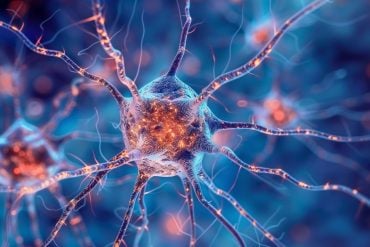Summary: SNRI antidepressants appear to be effective in the treatment of a range of pain conditions including neuropathic pain, fibromyalgia, and postoperative pain. Tricyclic antidepressants may not be effective in the treatment of pain.
Source: University of Sydney
Many people are unaware that some antidepressants (medications used to treat people living with depression) are also being prescribed to treat certain chronic pain conditions.
One in five people experience chronic pain in Australia and globally, and treatment of chronic pain is often suboptimal, with commonly used medicines having limited or unknown benefits. The use of antidepressants to help manage a person’s pain is on the rise, even when they do not have a mood disorder like depression.
An international team of researchers has found that some classes of antidepressants were effective in treating certain pain conditions in adults, but others were either not effective, or the effectiveness was unknown.
Published in The BMJ, the study reviewed the safety and effectiveness of antidepressants in the treatment of chronic pain.
The researchers say the results show that clinicians need to consider all the evidence before deciding to prescribe antidepressants for chronic pain management.
“This review, for the first time, brings together all the existing evidence about the effectiveness of antidepressants to treat chronic pain in one comprehensive document,” said lead author Dr Giovanni Ferreira from The Institute for Musculoskeletal Health and Sydney Musculoskeletal Health at the University of Sydney.
The review examined 26 systematic reviews from 2012 to 2022 involving over 25,000 participants. This included data from 8 antidepressant classes and 22 pain conditions including back pain, fibromyalgia, headaches, postoperative pain, and irritable bowel syndrome.
Serotonin-norepinephrine reuptake inhibitors (SNRI) antidepressants such as duloxetine were found to be effective for the largest number of pain conditions, such as back pain, knee osteoarthritis, postoperative pain, fibromyalgia, and neuropathic pain (nerve pain).
By contrast tricyclic antidepressants, such as amitriptyline, are the most commonly used antidepressant to treat pain in clinical practice, but the review showed that it is unclear how well they work, or whether they work at all for most pain conditions.
The use of antidepressants as a treatment for pain has recently gained attention globally. A 2021 guideline for chronic primary pain management published by The National Institute for Health and Care Excellence (NICE) recommends against using pain medicines with the exception of antidepressants.
The guideline recommends different types of antidepressants, such as amitriptyline, citalopram, duloxetine, fluoxetine, paroxetine or sertraline for adults living with chronic primary pain.
Dr Ferreira said a more nuanced approach to prescribing antidepressants for pain is needed.
“Recommending a list of antidepressants without careful consideration of the evidence for each of those antidepressants for different pain conditions may mislead clinicians and patients into thinking that all antidepressants have the same effectiveness for pain conditions. We showed that is not the case.”
Co-author Dr Christina Abdel Shaheed from The School of Public Health and Sydney Musculoskeletal Health at the University of Sydney said:
“The findings from this review will support both clinicians and patients to weigh up the benefits and harms of antidepressants for various pain conditions so that they can make informed decisions about whether and when to use them.”
Dr Ferreira said that there are multiple treatment options for pain, and people should not rely solely on pain medicines for pain relief.

“Some pain medicines may have a role in pain management, but they need to be considered as only part of the solution. For some pain conditions, exercise, physiotherapy, and lifestyle changes may also help. Speak to your health professional to learn more about what alternatives might be appropriate for you,” Dr Ferreira said.
Professor Christopher Maher, Co-Director of Sydney Musculoskeletal Health at the University of Sydney, said, “This review distilled the evidence from over 150 clinical trials into an accessible summary that clinicians can use to help them make better decisions for their patients with chronic pain.”
The current status of antidepressants in Australia and globally
Most antidepressant prescriptions for pain are ‘off-label’, which is when antidepressants have not been approved to be prescribed for pain.
Many antidepressants are thought to help with pain by acting on chemicals in the brain that can assist with pain relief, such as serotonin. However, it is unknown exactly why some antidepressants improve pain. In Australia, the only antidepressant approved for treating pain is duloxetine, which is approved for diabetic neuropathic pain (nerve pain caused by diabetes).
Amitriptyline is approved in the United Kingdom for some pain conditions, such as neuropathic pain (nerve pain), tension-type headaches and migraines, but it is not approved for treating any pain conditions in Australia.
The use of antidepressants has doubled in OECD countries from 2000 to 2015, and the use of ‘off-label’ prescriptions of antidepressants for pain is considered a contributing factor to this increase. Data from Canada, the United States, the United Kingdom and Taiwan, suggest that among older people, chronic pain was the most common condition leading to an antidepressant prescription, even more so than depression.
Currently, no data from Australia shows how many antidepressant prescriptions are for pain.
Note: Antidepressants are prescription-only medicines. Do not use antidepressants unless advised by a doctor. It is very important not to abruptly cease treatment with antidepressant medicines. This can lead to withdrawal effects which can be distressing and sometimes present as serious health issues. These withdrawal effects include dizziness, nausea, anxiety, agitation, tremor, sweating, confusion, and sleep disturbance.
About this pain and neuropharmacology research news
Author: Ivy Shih
Source: University of Sydney
Contact: Ivy Shih – University of Sydney
Image: The image is in the public domain
Original Research: Open access.
“Efficacy, safety, and tolerability of antidepressants for pain: an overview of systematic reviews” by Giovanni Ferreira et al. BMJ
Abstract
Efficacy, safety, and tolerability of antidepressants for pain: an overview of systematic reviews
Objective
To provide a comprehensive overview of the efficacy, safety, and tolerability of antidepressants for pain according to condition.
Design
Overview of systematic reviews.
Data sources
PubMed, Embase, PsycINFO, and the Cochrane Central Register of Controlled Trials from inception to 20 June 2022.
Eligibility criteria for selecting studies
Systematic reviews comparing any antidepressant with placebo for any pain condition in adults.
Data extraction and synthesis
Two reviewers independently extracted data. The main outcome measure was pain; for headache disorders it was frequency of headaches. Continuous pain outcomes were converted into a scale of 0 (no pain) to 100 (worst pain) and were presented as mean differences (95% confidence intervals). Dichotomous outcomes were presented as risk ratios (95% confidence intervals). Data were extracted from the time point closest to the end of treatment. When end of treatment was too variable across trials in a review, data were extracted from the outcome or time point with the largest number of trials and participants. Secondary outcomes were safety and tolerability (withdrawals because of adverse events). Findings were classified from each comparison as efficacious, not efficacious, or inconclusive. Certainty of evidence was assessed with the grading of recommendations assessment, development, and evaluation framework.
Results
26 reviews (156 unique trials and >25 000 participants) were included. These reviews reported on the efficacy of eight antidepressant classes covering 22 pain conditions (42 distinct comparisons). No review provided high certainty evidence on the efficacy of antidepressants for pain for any condition. 11 comparisons (nine conditions) were found where antidepressants were efficacious, four with moderate certainty evidence: serotonin-norepinephrine reuptake inhibitors (SNRIs) for back pain (mean difference −5.3, 95% confidence interval −7.3 to −3.3), postoperative pain (−7.3, −12.9 to −1.7), neuropathic pain (−6.8, −8.7 to −4.8), and fibromyalgia (risk ratio 1.4, 95% confidence interval 1.3 to 1.6). For the other 31 comparisons, antidepressants were either not efficacious (five comparisons) or the evidence was inconclusive (26 comparisons).
Conclusions
Evidence of efficacy of antidepressants was found in 11 of the 42 comparisons included in this overview of systematic reviews—seven of the 11 comparisons investigated the efficacy of SNRIs. For the other 31 comparisons, antidepressants were either inefficacious or evidence on efficacy was inconclusive. The findings suggest that a more nuanced approach is needed when prescribing antidepressants for pain conditions.







